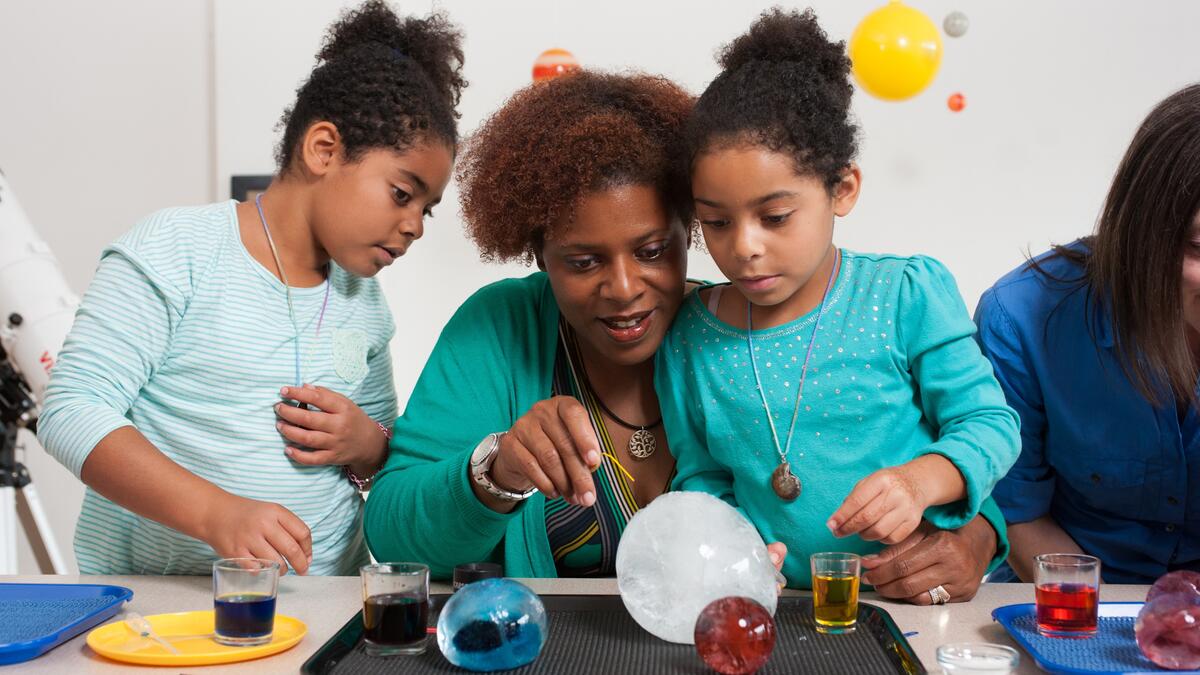NASA has announced funding nine new proposals for the next phase of its Science Activation (SciAct) program, a community based approach to connect NASA science with learners of all ages. These new awardees join a network of 21 programs that received extensions into the next phase of the NASA program.
Arizona State University has received funding for four of the 30 projects, making it a leader in NASA’s SciAct program.
The Science Activation Program is a cooperative network of competitively selected teams across the U.S. that connect NASA science experts, real content and experiences with community leaders to do science in ways that activate minds and promote deeper understanding of our world and beyond.
“Through innovative partnerships and networks, we’re enabling learners of all ages and backgrounds to participate in the advancement of knowledge,” said Kristen Erickson, director of science engagement and partnerships at NASA, Washington, D.C. “I’m thrilled to have this accomplished group of awardees join our Science Activation portfolio.”
The selections and extensions were made by the agency’s Science Mission Directorate (SMD) and will support the science discipline areas of earth science, astrophysics, planetary science and heliophysics.
“We now have four project teams that are based at ASU, two of which are new selections and two are continuing awards,” said Meenakshi Wadhwa, director of ASU’s School of Earth and Space Exploration and a principal investigator on one of the new NASA grants. “Together, these projects set up ASU as an education ‘hub’ for NASA and, even more broadly, for the general public.”
Here is a closer look at the four ASU programs.
SCoPE project
One of the new NASA SciAct awards for ASU is for a program from the School of Earth and Space Exploration called the NASA SMD Community of Practice for Education (SCoPE), led by Wadhwa and developed with the school’s Center for Education Through eXploration.
With a budget of $5 million, this five-year project will develop a process that makes it easier for NASA-funded subject matter experts to discover NASA SciAct projects that match their interests and expertise.
“There are many subject matter experts within NASA mission teams and beyond who want to contribute their expertise to advance national educational goals but are not aware of SciAct or how to connect with it,” Wadhwa said. “At the same time, SciAct teams create excellent educational resources but often struggle to engage broadly, efficiently and inclusively with expert scientists. SCoPE aims to bring these two communities together in an effective and self-sustaining process.”
The SCoPE team includes: Jessica Swann, deputy principal investigator for SciAct engagement, who will be responsible for facilitating connections between the SciAct community and subject matter experts; David Williams, deputy principal investigator for subject matter engagement, who will be responsible for generating interest and recruiting NASA-funded subject matter experts for connection with the SciAct; and co-investigators Ariel Anbar, Greg Asner, Jim Bell, Katrina Bossert, Chris Mead and Evgenya Shkolnik. New School of Earth and Space Exploration faculty member Molly Simon is a collaborator.
“SCoPE leverages ASU’s great strength in subject matter expertise in all areas of NASA science, as well as the depth of experience and expertise of key members of our team who are part of ASU’s thriving education ecosystem,” Wadhwa said.
SciAct STEM Ecosystems
It takes a lot of resources to create a successful STEM learning experience. STEM ecosystems bring all those resources together, developing mutually beneficial partnerships and implementing best practices to broaden STEM participation.
It puts the learner in the center, surrounded by different organizations and opportunities to learn. NASA plays an important role in that ecosystem, so ASU is working with NASA to make these ecosystems more successful. As part of a nearly $5 million NASA SciAct award, the SciAct STEM Ecosystems project will research ways to create authentic STEM learning experiences.
“The focus of the project is looking at how the concept and organization of STEM learning ecosystems can accomplish two goals,” said Rae Ostman, associate research professor in the School for the Future of Innovation in Society, director of the National Informal STEM Education Network (NISE Net) and co-director of the Center for Innovation in Informal STEM Learning (CIISL). “One is focusing on improving diversity, equity, inclusion and access in STEM learning. The other is integrating subject matter experts or scientists into these ecosystems.”
Ostman is the principal investigator for the new five-year project, a collaboration between NISE Net, CIISL, the Arizona Science Center, the Rural Activation and Innovation Network, University of Alaska Fairbanks and Southwestern Community College. The project will take a closer look at STEM ecosystems by completing a landscape study and developing a guiding framework for the principles and practices of learning ecosystems that create equitable partnerships, and implementing and studying exemplary ecosystems that leverage NASA's Science Mission Directorate’s unique assets. It will also provide professional development training and resources to SciAct participants to support learning related to STEM ecosystem principles and practices and facilitate widespread dissemination and sustainability of project findings and resources among professionals active in STEM engagement and education. The project is a way to broaden participation in STEM learning by working together across organizations.
“This project is going to provide an opportunity to really focus on the kind of authentic science that ASU is conducting right now,” Ostman said. “I'm looking forward to working across all of the projects that are part of SciAct and cross-collaborating with colleagues.”
Infiniscope (originally NASA Exploration Connection)
ASU’s Infiniscope program, led by President’s Professor Ariel Anbar of the School of Earth and Space Exploration, was selected for award renewal this year by NASA’s SciAct program. This five-year program, with a budget of $10.8 million, is a continuation of the Infiniscope team’s 2016 award to transform teaching and learning of earth and space sciences in K–12 education.
“Infiniscope inspires curiosity, engagement and confidence by connecting learners and educators with innovative, interactive, inquiry-driven digital learning experiences,” Anbar said. “The experiences adapt to the learner, guiding their discovery of earth and space science concepts.”
For the renewed funding, Anbar and his team will shift their emphasis from network growth to deeper engagement with key partner schools and teacher networks to collaboratively create a new generation of digital learning experiences and associated professional development resources. The new experiences will systematically address key learning objectives in earth and space science education in middle school and high school.
The Infiniscope team is composed of a variety ASU individuals, many of whom were formal classroom teachers prior to their work at ASU. The group within the Center for Education Through eXploration includes learning designers, software developers and user experience specialists. The center is led by Anbar and Assistant Director Joseph Tamer, who both ensure vision and outcomes for the project are maintained, community manager Jessica Swann who recruits, trains and supports the teaching community of practice, and research manager Chris Mead, who collects and provides evaluation metrics of the overall effectiveness of the program.
Space and Earth Informal STEM education
Learning doesn’t just happen in the classroom. The world is full of informal learning opportunities; we learn from friends, family, museums and libraries. But learning in these types of settings can be challenging. If it’s not interactive or fun, it may not be effective.
ASU and NASA are working to keep people engaged and make informal learning more accessible through the Space and Earth Informal STEM Education (SEISE) project.
“We’re always learning, and much of that learning comes outside of school,” said Principal Investigator Paul Martin, research professional in the School for the Future of Innovation in Society and co-director of the Center for Innovation in Informal STEM Learning. “We’re creating fun activities to make that informal learning more effective.”
The project, which is a continuation of one that started at the Science Museum of Minnesota in 2015 and transferred to ASU in 2017, received a NASA SciAct award worth nearly $3.5 million. Through the National Informal STEM Education Network, SEISE creates hands-on activity toolkits and distributes them to their museum and science center partners. The toolkits are then used in workshops, classes and camps to teach people about STEM in interactive and fun ways.
The project also creates exhibitions and professional development opportunities. In just a few years, it has already reached 15 million people. As the project continues over the next two years, the goal is to engage learners of all ages and get more people interested in STEM.
“It’s about seeing STEM as something fun that’s connected to your life,” Martin said. “By understanding STEM and working with it, you can make your life better and make a better world for the future.”
Ashley Richards and Karin Valentine contributed to this article.
Top photo courtesy NISE Network.
More Science and technology

From food crops to cancer clinics: Lessons in extermination resistance
Just as crop-devouring insects evolve to resist pesticides, cancer cells can increase their lethality by developing resistance to treatment. In fact, most deaths from cancer are caused by the…

ASU professor wins NIH Director’s New Innovator Award for research linking gene function to brain structure
Life experiences alter us in many ways, including how we act and our mental and physical health. What we go through can even change how our genes work, how the instructions coded into our DNA are…

ASU postdoctoral researcher leads initiative to support graduate student mental health
Olivia Davis had firsthand experience with anxiety and OCD before she entered grad school. Then, during the pandemic and as a result of the growing pressures of the graduate school environment, she…
